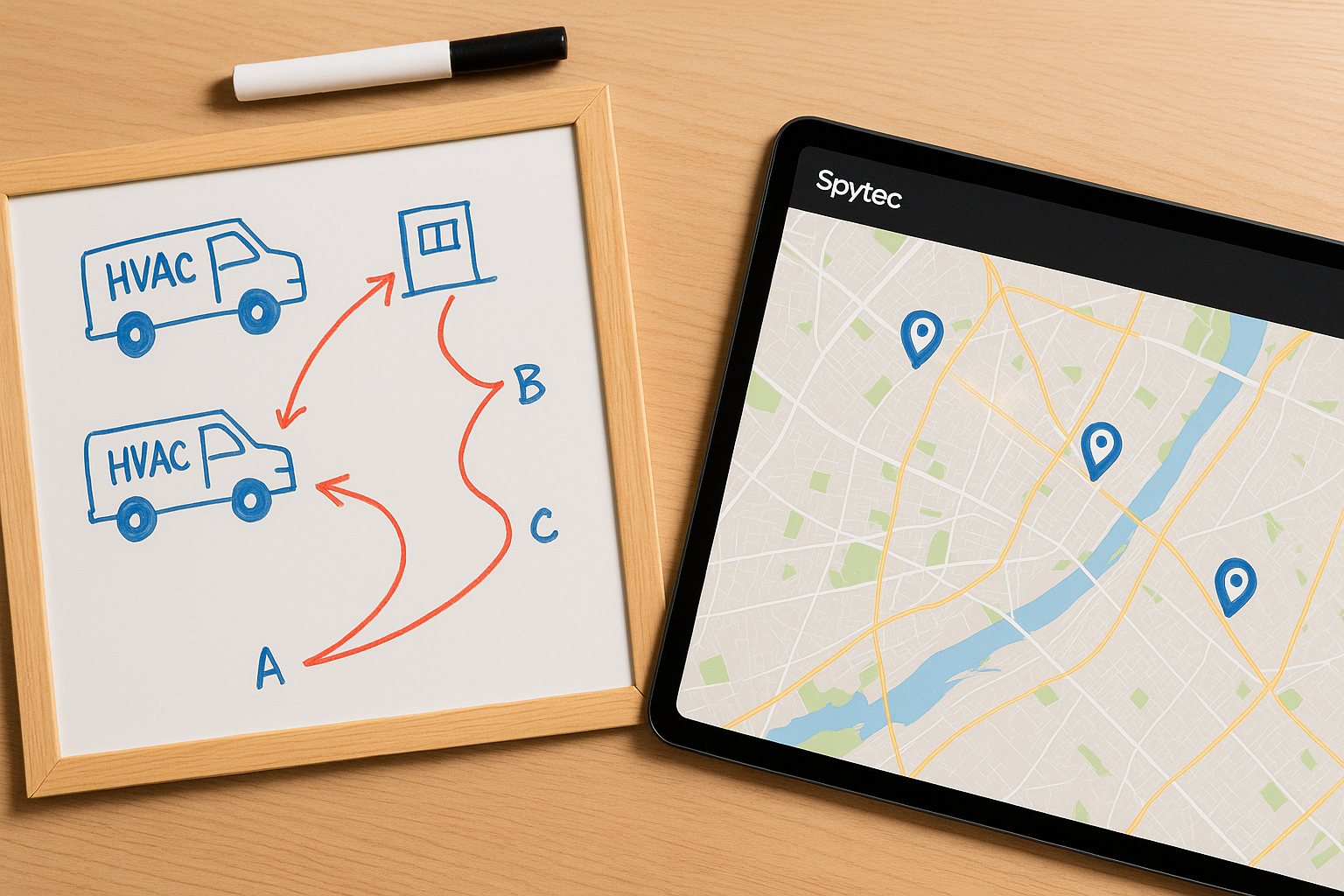HVAC GPS Fleet Tracking: 5 Ways You’re Losing Money Without It (And How to Fix Each One)
If you run an HVAC company with a handful of trucks, you probably already know where today’s fires are. What you don’t see clearly is where the money leaks out of your fleet every day:
- A tech taking the long way to a job
- A van doing “just one” side job
- Extra fuel burned idling in a driveway
- A surprise breakdown that kills a day’s schedule
HVAC GPS fleet tracking won’t fix bad weather or bad parts, but it does close most of the invisible leaks. With our HVAC fleet tracking software, you can see where every truck is in real time and control how your vehicles are used without changing everything about the way you work.
1. Wasted Time Between Jobs and Inefficient Routes
The problem
Without live vehicle locations you’re guessing:
- “Who’s actually closest?”
- “Can they squeeze in one more call?”
- “Why did that job take 2.5 hours instead of 1.5?”
Drivers pick their own routes. Dispatchers rely on phone calls and texts. You lose:
- Extra drive time between jobs
- Fewer jobs per tech per day
- More overtime to finish the schedule
How HVAC GPS fleet tracking fixes it
With live tracking and route history, you can:
- See every truck on a live map with frequent updates (down to 1-second reporting when you want it).
- Dispatch the closest tech to the next job instead of whoever answers the phone first.
- Review actual routes at the end of the day and cut out “creative” detours.
In practice this means:
- 1–2 extra jobs per truck per week
- Fewer “where are you now?” calls
- Less overtime just to finish a normal schedule
2. Unbillable Overtime, Side Jobs, and Time Theft
The problem
You pay by the hour. Customers pay by the job. The delta can hurt.
Common HVAC realities:
- Techs start late and clock out late
- Long lunches and unnecessary stops
- “Side jobs” done off the clock in your van, using your gas
Without GPS data you’re relying on trust and timesheets.
How HVAC GPS fleet tracking fixes it
With a fleet tracking system, you can:
- See exact start/stop times, not just what’s on a timesheet.
- Get a full log of where each truck went, and for how long.
- Flag patterns like:
- Repeated long stops at the same non-job address
- Vehicles moving during off-hours
- Clocked-in time that doesn’t match vehicle movement
You can set:
- Off-hours alerts: get a notification if a van moves outside defined business hours.
- Geofence alerts: alerts when a vehicle enters/leaves key zones (yard, customer sites, tech’s home).
Over time, this usually leads to:
- Less overtime you can’t justify
- Fewer “mystery hours”
- Side jobs dropping off because techs know trips are visible
If you want this level of visibility, our HVAC GPS fleet tracking solution is built specifically for 5–25-truck HVAC shops that don’t have a full-time fleet manager.
3. Extra Fuel Burned Through Idling and Bad Driving
The problem
Fuel is one of your biggest variable costs. You lose money when:
- Trucks idle at jobs with A/C blasting for 30–60 minutes
- Techs speed between jobs or drive aggressively
- Drivers take longer routes or sit in avoidable traffic
Most owners only see the fuel card statements, not the behavior behind them.
How HVAC GPS fleet tracking fixes it
A proper fleet tracker gives you:
- Idling reports: how much each vehicle idled, where, and when.
- Driver behavior: speeding, harsh braking, fast acceleration, hard cornering.
- Route history: actual routes versus what should have happened.
With an OBD telematics device, you can go deeper:
- Fuel level and consumption trends (where supported)
- Correlate driver behavior with fuel usage
What you do with this:
- Set a clear idling policy (e.g., “no more than X minutes”) and back it with data.
- Coach repeat offenders on speeding and harsh driving.
- Adjust routes based on where trucks are consistently stuck.
Result: fuel spend moves from “shrug” to a managed, predictable line item.
4. Breakdowns, Surprise Repairs, and Poor Maintenance
The problem
HVAC trucks are mobile offices. When one dies:
- You cancel or reschedule a day’s worth of jobs
- You still pay the tech
- You pay for a tow, rush repair, maybe a rental
Most smaller HVAC companies run maintenance on gut feel:
- “That van feels like it’s due.”
- “We’ll take it in next week if there’s time.”
No odometer tracking, no automated reminders, no visibility into how hard the trucks are being driven.
How HVAC GPS fleet tracking fixes it
With OBD telematics devices, you can see:
- Automatic odometer readings for each vehicle
- Fault codes when something is wrong
- Maintenance scheduling by miles, hours, or time
With both OBD and hardwired options you can:
- Put OBD in the main service vans to monitor engine health.
- Use hardwired units where you just need location and driver behavior.
This lets you:
- Set maintenance schedules and get alerts before a truck is overdue.
- See which techs are beating up vehicles with harsh driving.
- Use fault codes and check-engine alerts to fix problems early.
Fewer “truck died on the highway” moments mean fewer lost days of revenue.
5. Lost Jobs and Angry Customers From Missed or Late Arrivals
The problem
HVAC customers want tight arrival windows and clear communication. Without GPS:
- Dispatch guesses at ETAs.
- If a customer calls, office staff call the tech, then call the customer back.
- When someone claims “your tech never showed,” it’s your word versus theirs.
This leads to:
- Lost jobs when people give up and call another company
- Discounts or write-offs to “keep them happy”
- Bad reviews that hurt future bookings
How HVAC GPS fleet tracking fixes it
With live and historical location data, you can:
- Let CSRs see exactly where every truck is and give real ETAs.
- Prove a tech was on-site at a specific time if there’s a dispute.
- See patterns of chronic lateness or slow job turns.
Practical moves:
- When a customer calls, the office can say, “They’re about 8 minutes away, just finishing the previous job,” instead of guessing.
- If someone claims a no-show, you can pull up history and see:
- Was the tech there?
- For how long?
- Set geofences for key customers and get alerts when a truck arrives or leaves.
This reduces friction, protects your reputation, and lets you enforce standards with real data.
OBD vs Hardwired for HVAC Fleets (Simple View)
For most HVAC vans and trucks:
OBD telematics is usually the default:
- Fast to install (minutes per vehicle)
- Full telematics: odometer, fault codes, fuel level (where supported), driver behavior
- Easy to move between vehicles if your fleet changes
Hardwired devices make sense when:
- You don’t care about engine data; you mainly need location and driver behavior.
- You’re installing on vehicles where OBD isn’t ideal or accessible.
- You want a more “hidden” install to reduce tampering.
For a typical small HVAC company, a simple pattern works:
- Use OBD on most service vans for full visibility into vehicle health and driver behavior.
- Use hardwired units on edge cases where you just need tracking.
Our HVAC GPS fleet tracking offering supports both options, so you can mix and match based on each vehicle instead of forcing a one-size-fits-all setup.
Why a Self-Serve System Matters for a 5–25 Truck HVAC Shop
Most fleet systems that do all of this are built for large fleets and force you into:
- Sales calls and demos
- Contract negotiations
- Per-vehicle minimums and onboarding fees
For a 5–25 vehicle HVAC company, that’s overkill.
A self-serve model fits better:
- Sign up online without talking to sales.
- Choose how many trackers you need and add more as you grow.
- Hardware included with the subscription instead of a big upfront bill.
- Volume discounts as you add vehicles.
- Install OBD devices in minutes and see trucks on the map right away.
You get enterprise-grade fleet control without needing a fleet manager or an IT project. With self-serve HVAC GPS fleet tracking, you can sign up, add vehicles, and start seeing trucks live on the map in a single afternoon.
What to Do Next
If you’re running an HVAC company with a few trucks and you recognize any of this, here’s a simple next step:
-
List your fleet leaks
Overtime, fuel, side jobs, breakdowns, missed jobs. -
Estimate the monthly cost
Even a rough back-of-the-envelope number usually justifies fleet tracking. -
Pilot with a subset of vehicles
Start with 5–10 vans, track for 60–90 days, and measure:- Overtime hours
- Fuel usage
- Jobs per tech per day
- Customer complaints vs before
Ready to see it in action?
Explore HVAC GPS fleet tracking, choose how many vehicles you want to start with, and get your trucks online without ever talking to a salesperson.


Share:
What’s the best magnetic GPS tracker for car theft prevention?
How HVAC Companies Use GPS Fleet Tracking to Fit in More Jobs Per Day (Without Adding Vans)